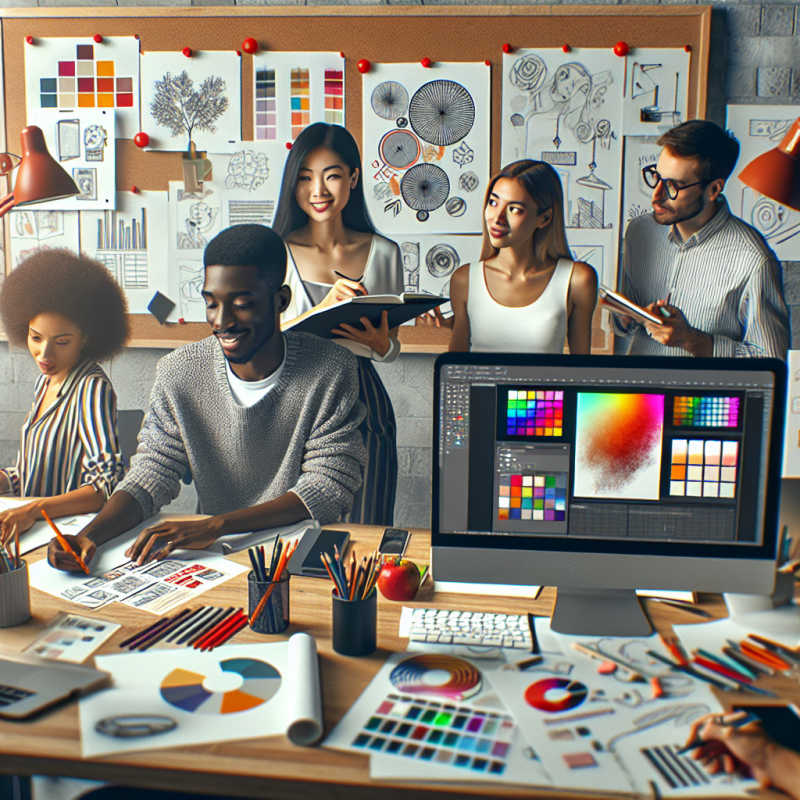Contrary to popular belief, landing a top-tier graphic design job isn’t just about raw talent; it’s a strategic game that involves mastering high-demand roles, honing essential skills, curating an impressive portfolio, and leveraging networking opportunities. In this article, we’ll delve into the most sought-after positions in the graphic design industry, from UX/UI Designers to Motion Graphics Designers, and break down the skills and tools you need to excel. We’ll also guide you on how to build a standout portfolio, navigate the job market, and ace those crucial interviews. Whether you’re a seasoned designer or just starting, this comprehensive guide will equip you with the insights and strategies to secure your dream job in graphic design.
Exploring High-Demand Graphic Design Roles
In the ever-evolving world of graphic design, certain roles are in particularly high demand. If you’re looking to break into the industry or pivot within it, understanding these roles can give you a significant edge. Let’s dive into some of the most sought-after positions and what they entail.
- UX/UI Designer: This role focuses on the user experience and interface design. UX/UI Designers are responsible for creating intuitive and engaging interfaces for websites, apps, and other digital platforms. Their work ensures that users have a seamless and enjoyable experience.
- Brand Designer: A Brand Designer is tasked with creating the visual identity for brands. This includes designing logos, color schemes, typography, and other elements that represent a brand’s image and values. Their work is crucial in establishing a brand’s presence in the market.
- Motion Graphics Designer: Specializing in animated graphics, Motion Graphics Designers bring static designs to life. They work on everything from animated logos to complex video graphics, making content more dynamic and engaging.
| Job Title | Description |
|---|---|
| UX/UI Designer | Focuses on user experience and interface design. |
| Brand Designer | Creates visual identity for brands. |
| Motion Graphics Designer | Specializes in animated graphics. |
These roles are just the tip of the iceberg in the graphic design industry. Each offers unique opportunities and challenges, making them exciting career paths for creative professionals. Whether you’re drawn to the analytical side of UX/UI design or the creative flair of brand and motion graphics design, there’s a high-demand role waiting for you.
Essential Skills and Tools for Graphic Designers
To thrive in the competitive world of graphic design, you need a blend of key skills and essential tools. Let’s dive into what makes a graphic designer stand out and the tools that can elevate your work to the next level.
First off, here are the crucial skills every graphic designer should master:
- Creativity: The ability to generate unique and innovative ideas is paramount. Whether you’re designing a logo or a full-blown marketing campaign, creativity is your best friend.
- Communication: Effectively conveying your ideas to clients and team members is essential. Good communication ensures that your vision aligns with the client’s expectations.
- Technical Skills: Proficiency in industry-standard software is non-negotiable. This includes tools like Adobe Creative Suite, Sketch, and Figma.
Now, let’s talk about the essential tools that every graphic designer should be familiar with:
- Adobe Creative Suite: This is the gold standard in the industry. From Photoshop to Illustrator, mastering these tools will give you a significant edge.
- Sketch: Particularly popular for UI/UX design, Sketch offers a streamlined interface and powerful features.
- Figma: A collaborative design tool that’s perfect for team projects. Its cloud-based nature allows for real-time collaboration.
In real-world projects, these skills and tools come together to create stunning designs. For instance, your creativity might lead you to a unique logo concept, while your technical skills in Adobe Illustrator bring that concept to life. Effective communication ensures that your client loves the final product, and tools like Figma make it easy to collaborate with other designers and stakeholders.
Mastering these essential skills and tools will not only make you a better graphic designer but also significantly increase your chances of landing top graphic design jobs. So, invest time in honing these abilities and familiarizing yourself with the industry-standard tools.
Building a Standout Graphic Design Portfolio
In the competitive world of graphic design, a strong portfolio is your golden ticket to landing top jobs. It’s not just about showcasing your skills; it’s about telling a story that resonates with potential employers. A well-crafted portfolio should include a diverse range of projects, from branding to web design, to demonstrate your versatility. Don’t just show the final product; include case studies that explain your design process, challenges you faced, and how you overcame them. This gives employers insight into your problem-solving abilities and creative thinking.
To make your portfolio uniquely yours, focus on personal branding. This means using a consistent style, color scheme, and tone that reflects your personality and design philosophy. Platforms like Behance, Dribbble, and personal websites are excellent places to showcase your work. Look at successful portfolios for inspiration; what makes them effective is often their clarity, creativity, and the ability to tell a compelling story. Remember, your portfolio is not just a collection of your best work; it’s a strategic tool designed to get you noticed and hired.
Networking and Job Hunting Strategies for Graphic Designers
In the graphic design industry, networking is your secret weapon. It’s not just about who you know, but who knows you. Building a professional network can open doors to opportunities you never knew existed. Start by attending industry events where you can meet potential employers and peers. These events are gold mines for making connections that can lead to job offers or collaborations. Don’t underestimate the power of online communities either. Join forums, participate in discussions, and engage with other designers on platforms like LinkedIn and Behance. Social media is another powerful tool; use it to showcase your work and connect with industry leaders.
When it comes to job hunting, a generic resume won’t cut it. Tailor your resume and cover letter to highlight your relevant skills and experience. Make sure to include keywords that match the job description. Here are some actionable tips:
- Attend industry events: Meet potential employers and peers.
- Join online communities: Engage with other designers and stay updated on industry trends.
- Tailor your resume: Highlight relevant skills and experience to match the job description.
By leveraging these strategies, you’ll not only expand your network but also increase your chances of landing that dream graphic design job. Remember, in this field, your connections can be just as valuable as your portfolio.
Preparing for Graphic Design Job Interviews
Landing a top graphic design job isn’t just about having a killer portfolio; it’s also about nailing the interview. Here are some essential tips to help you prepare:
- Research the Company: Before your interview, make sure you know the company’s design style, mission, and recent projects. This will help you tailor your answers and show that you’re genuinely interested in the role.
- Practice Common Interview Questions: Be ready to answer questions like Can you describe your design process? or How do you handle tight deadlines? Practice your responses to ensure they are clear and concise.
- Portfolio Presentation: During the interview, highlight key projects in your portfolio. Explain your role in each project, the challenges you faced, and how you overcame them. This will demonstrate your problem-solving skills and creativity.
- Follow-Up: After the interview, send a thank-you email to express your appreciation. Mention specific points from the interview to show that you were engaged and attentive. This small gesture can leave a lasting positive impression.
By following these tips, you’ll be well-prepared to impress potential employers and land your dream graphic design job. Remember, confidence and preparation are key!
Frequently Asked Questions
- Staying current in the graphic design field involves continuous learning. You can take online courses, attend workshops, and follow industry blogs and influencers. Additionally, practicing regularly and experimenting with new tools and techniques can help you stay ahead.
- Specializing in a specific area, such as UX/UI design or motion graphics, can make you more attractive to employers looking for expertise in that niche. However, having a broad skill set can also be beneficial, especially for freelance work or smaller companies that need versatile designers.
- Your graphic design resume should highlight your relevant skills, experience, and education. Include a link to your portfolio, list any design tools you are proficient in, and mention any notable projects or clients you have worked with. Tailor your resume to the specific job you are applying for.
- To get freelance graphic design work, start by building a strong portfolio and showcasing it on platforms like Behance and Dribbble. Network with other designers and potential clients through social media and industry events. You can also join freelance marketplaces like Upwork or Fiverr to find job opportunities.
- Common mistakes in graphic design job interviews include not being prepared to discuss your portfolio in detail, failing to research the company beforehand, and not asking insightful questions about the role or company. Additionally, ensure you communicate your design process clearly and confidently.




